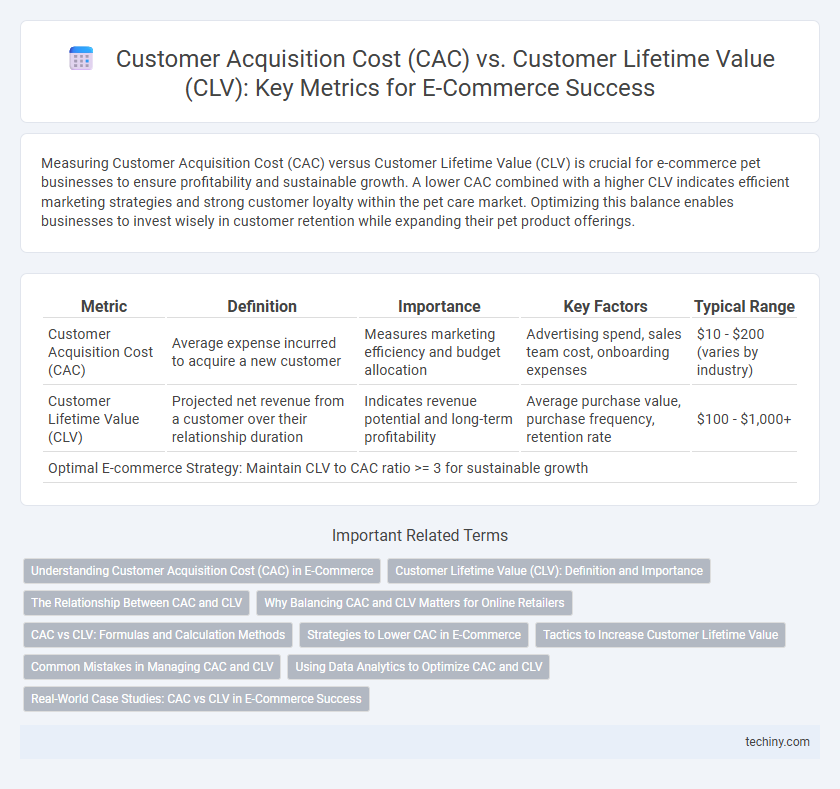Measuring Customer Acquisition Cost (CAC) versus Customer Lifetime Value (CLV) is crucial for e-commerce pet businesses to ensure profitability and sustainable growth. A lower CAC combined with a higher CLV indicates efficient marketing strategies and strong customer loyalty within the pet care market. Optimizing this balance enables businesses to invest wisely in customer retention while expanding their pet product offerings.
Table of Comparison
| Metric | Definition | Importance | Key Factors | Typical Range |
|---|---|---|---|---|
| Customer Acquisition Cost (CAC) | Average expense incurred to acquire a new customer | Measures marketing efficiency and budget allocation | Advertising spend, sales team cost, onboarding expenses | $10 - $200 (varies by industry) |
| Customer Lifetime Value (CLV) | Projected net revenue from a customer over their relationship duration | Indicates revenue potential and long-term profitability | Average purchase value, purchase frequency, retention rate | $100 - $1,000+ |
| Optimal E-commerce Strategy: Maintain CLV to CAC ratio >= 3 for sustainable growth | ||||
Understanding Customer Acquisition Cost (CAC) in E-Commerce
Customer acquisition cost (CAC) in e-commerce measures the total marketing and sales expenses required to acquire a new customer, including advertising spend, promotions, and operational costs. Analyzing CAC helps businesses optimize their marketing strategies by identifying the most cost-effective channels for attracting customers. Monitoring CAC alongside customer lifetime value (CLV) ensures sustainable growth by aligning acquisition costs with the long-term revenue generated from each customer.
Customer Lifetime Value (CLV): Definition and Importance
Customer Lifetime Value (CLV) quantifies the total revenue a business can expect from a single customer throughout their entire relationship, directly influencing profitability strategies. Understanding CLV helps e-commerce companies allocate marketing budgets efficiently, optimize customer retention, and identify high-value customer segments. Maximizing CLV ensures sustainable growth by balancing acquisition costs with long-term revenue potential.
The Relationship Between CAC and CLV
Customer acquisition cost (CAC) determines the investment required to gain a new customer, while customer lifetime value (CLV) estimates the total revenue generated from that customer over time. An optimal e-commerce strategy balances CAC and CLV to ensure sustainable profitability, typically aiming for a CLV that is at least three times higher than CAC. When CLV exceeds CAC by a significant margin, it indicates efficient marketing spend and strong customer loyalty driving long-term growth.
Why Balancing CAC and CLV Matters for Online Retailers
Balancing Customer Acquisition Cost (CAC) and Customer Lifetime Value (CLV) is crucial for online retailers to ensure sustainable profitability and efficient marketing spend. High CAC without a proportionate increase in CLV leads to reduced profit margins, while optimizing CLV relative to CAC enables retailers to maximize long-term revenue from each customer. Monitoring this balance allows retailers to invest strategically in customer acquisition channels that deliver the highest return on investment and foster customer loyalty.
CAC vs CLV: Formulas and Calculation Methods
Customer Acquisition Cost (CAC) is calculated by dividing the total marketing and sales expenses by the number of new customers acquired, reflecting the average spend to gain a customer. Customer Lifetime Value (CLV) estimates the total revenue generated from a customer throughout their relationship with the business, often calculated as the average purchase value multiplied by purchase frequency and customer lifespan. Comparing CAC to CLV helps e-commerce businesses determine profitability by ensuring the CLV significantly exceeds the CAC, optimizing marketing investment strategies.
Strategies to Lower CAC in E-Commerce
Implement targeted social media advertising and leverage influencer partnerships to precisely reach high-conversion audiences, reducing Customer Acquisition Cost (CAC) in e-commerce. Optimize website user experience and implement automated email marketing campaigns to increase conversion rates and customer retention, thereby improving Customer Lifetime Value (CLV). Utilize data analytics to refine customer segmentation and personalize offers, resulting in more efficient marketing spend and sustainable growth in online sales.
Tactics to Increase Customer Lifetime Value
Implement personalized marketing strategies leveraging customer data to enhance Customer Lifetime Value (CLV) by tailoring product recommendations and exclusive offers. Implement loyalty programs and subscription models to encourage repeat purchases and increase retention rates. Optimize customer support and engagement through omnichannel communication to build trust and foster long-term relationships, reducing Customer Acquisition Cost (CAC) impact over time.
Common Mistakes in Managing CAC and CLV
Businesses often underestimate Customer Acquisition Cost (CAC) by failing to account for all marketing and sales expenses, leading to skewed profitability analysis. Overemphasis on short-term CAC reduction can result in neglecting Customer Lifetime Value (CLV), diminishing long-term revenue potential. Ignoring the balance between CAC and CLV causes inefficient budget allocation, hampering sustainable growth in e-commerce ventures.
Using Data Analytics to Optimize CAC and CLV
Data analytics enables e-commerce businesses to precisely measure Customer Acquisition Cost (CAC) and Customer Lifetime Value (CLV) by tracking customer behaviors, purchase patterns, and marketing channel effectiveness. Leveraging predictive analytics and segmentation models helps optimize marketing spend, reducing CAC while enhancing CLV through targeted retention strategies. Advanced data tools facilitate continuous monitoring and adjustment of acquisition campaigns, maximizing ROI and profitability.
Real-World Case Studies: CAC vs CLV in E-Commerce Success
Real-world case studies in e-commerce reveal that companies with a customer acquisition cost (CAC) significantly lower than their customer lifetime value (CLV) achieve sustainable growth and profitability. For example, successful brands report maintaining a CAC to CLV ratio of 1:3 or higher, ensuring marketing investments yield substantial returns over long-term customer relationships. Data from top platforms demonstrate that optimizing this ratio through targeted campaigns and retention strategies is crucial for maximizing revenue and competitive advantage in online retail.
Customer acquisition cost (CAC) vs Customer lifetime value (CLV) Infographic

 techiny.com
techiny.com